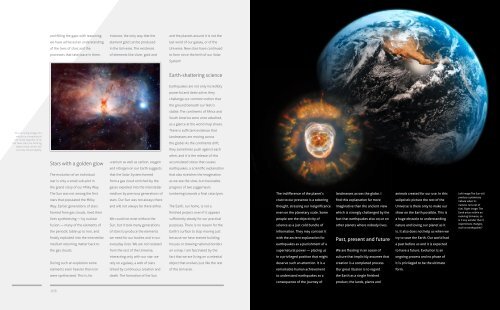Sol Lucet Omnibus - ESO
Sol Lucet Omnibus - ESO
Sol Lucet Omnibus - ESO
- TAGS
- lucet
- omnibus
- www.eso.org
Create successful ePaper yourself
Turn your PDF publications into a flip-book with our unique Google optimized e-Paper software.
This stunning image of a<br />
nebula is a snapshot of<br />
one small segment of its<br />
life. New stars are forming<br />
deep inside, which will<br />
one day shine brightly.<br />
and filling the gaps with reasoning<br />
we have achieved an understanding<br />
of the lives of stars and the<br />
processes that take place in them.<br />
Stars with a golden glow<br />
The evolution of an individual<br />
star is only a small sub-plot in<br />
the grand story of our Milky Way.<br />
The Sun was not among the first<br />
stars that populated the Milky<br />
Way. Earlier generations of stars<br />
formed from gas clouds, lived their<br />
lives synthesising — by nuclear<br />
fusion — many of the elements of<br />
the periodic table up to iron, and<br />
finally exploded into the interstellar<br />
medium returning matter back to<br />
the gas clouds.<br />
During such an explosion some<br />
elements even heavier than iron<br />
were synthesised. This is, for<br />
106<br />
instance, the only way that the<br />
element gold can be produced<br />
in the Universe. The existence<br />
of elements like silver, gold and<br />
uranium as well as carbon, oxygen<br />
and nitrogen on our Earth suggests<br />
that the <strong>Sol</strong>ar System formed<br />
from a gas cloud enriched by the<br />
gases expelled into the interstellar<br />
medium by previous generations of<br />
stars. Our Sun was not always there<br />
and will not always be there either.<br />
We could not exist without the<br />
Sun, but it took many generations<br />
of stars to produce the elements<br />
we need for our bodies and in our<br />
everyday lives. We are not isolated<br />
from the rest of the Universe,<br />
interacting only with our star: we<br />
rely on a galaxy, a web of stars<br />
linked by continuous creation and<br />
death. The formation of the Sun<br />
and the planets around it is not the<br />
last word of our galaxy, or of the<br />
Universe. New stars have continued<br />
to form since the birth of our <strong>Sol</strong>ar<br />
System!<br />
Earth-shattering science<br />
Earthquakes are not only incredibly<br />
powerful and destructive, they<br />
challenge our common notion that<br />
the ground beneath our feet is<br />
stable. The continents of Africa and<br />
South America were once attached,<br />
as a glance at the world map shows.<br />
There is sufficient evidence that<br />
landmasses are moving across<br />
the globe! As the continents drift,<br />
they sometimes push against each<br />
other, and it is the release of this<br />
accumulated stress that causes<br />
earthquakes, a scientific explanation<br />
that also stretches the imagination<br />
as we see the slow, but inexorable<br />
progress of two juggernauts<br />
lumbering towards a final cataclysm.<br />
The Earth, our home, is not a<br />
finished project, even if it appears<br />
sufficiently steady for our practical<br />
purposes. There is no reason for the<br />
Earth’s surface to stop moving just<br />
because we have started building<br />
houses or drawing national borders<br />
on a map. I am fascinated by the<br />
fact that we are living on a celestial<br />
object that evolves just like the rest<br />
of the Universe.<br />
The indifference of the planet’s<br />
crust to our presence is a sobering<br />
thought, stressing our insignificance<br />
even on the planetary scale. Some<br />
people see the objectivity of<br />
science as a just cold bundle of<br />
information. They may contrast it<br />
with the ancient explanation for<br />
earthquakes as a punishment of a<br />
supernatural power — placing us<br />
in a privileged position that might<br />
deserve such an attention. It is a<br />
remarkable human achievement<br />
to understand earthquakes as a<br />
consequence of the journey of<br />
landmasses across the globe. I<br />
find this explanation far more<br />
imaginative than the ancient view<br />
which is strongly challenged by the<br />
fact that earthquakes also occur on<br />
other planets where nobody lives.<br />
Past, present and future<br />
We are floating in an ocean of<br />
culture that implicitly assumes that<br />
creation is a completed process.<br />
Our great illusion is to regard<br />
the Earth as a single finished<br />
product; the lands, plants and<br />
animals created for our use. In this<br />
solipsistic picture the rest of the<br />
Universe is there only to make our<br />
show on the Earth possible. This is<br />
a huge obstacle to understanding<br />
nature and loving our planet as it<br />
is. It also does not help us when we<br />
try to save the Earth. Our world had<br />
a past before us and it is expected<br />
to have a future. Evolution is an<br />
ongoing process and no phase of<br />
it is privileged to be the ultimate<br />
form.<br />
107<br />
Left image:The Sun will<br />
produce a planetary<br />
nebula when its<br />
nucleus runs out of<br />
fuel. Right image: The<br />
Earth exists within an<br />
evolving Universe, so<br />
is it any wonder that it<br />
experiences changes,<br />
such as earthquakes?

















